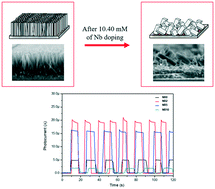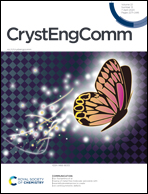Surface chemistry and growth mechanism of highly oriented, single crystalline Nb-doped TiO2 nanorods†
Abstract
Titanium dioxide (TiO2) is used in many applications in daily life. To enhance its properties further, rutile Nb-doped TiO2 nanorods were fabricated using the one-step hydrothermal method. Niobium was chosen as the dopant for its orbital state of Nb5+ to replace Ti4+ as it can provide an extra electron, increasing its carrier concentration. We studied the effect of the Nb dopant on the morphological changes in the TiO2 nanorods and their enhanced carrier transport. After doping, the diameter of the nanorods increased, while their thickness decreased, which could be related to the changes in the surface energy of Cl− with Nb doping, reducing the anisotropic growth. Meanwhile, nanorod density also decreased because Nb attached to the nanorod nucleation sites, inhibiting early growth. X-ray photoelectron spectroscopy (XPS) analysis revealed the existence of Nb on the surface and bulk TiO2 nanorods. The photocurrent measurements of Nb-doped TiO2 showed 2.3 times improvement compared to that for pristine TiO2 nanorods, indicating their enhanced carrier transport.



 Please wait while we load your content...
Please wait while we load your content...